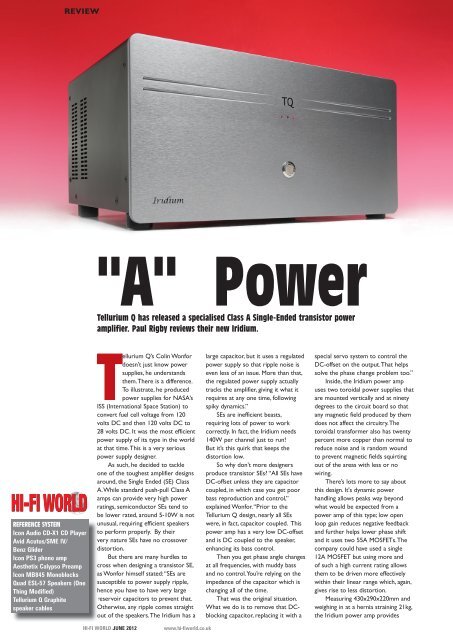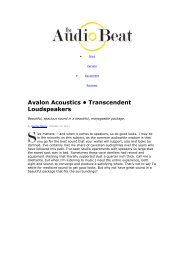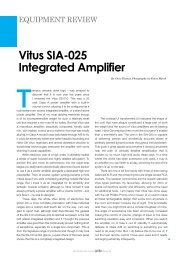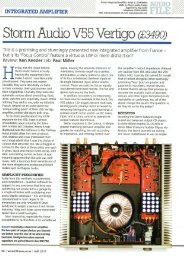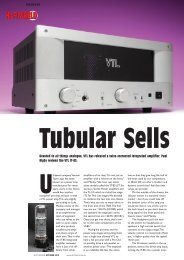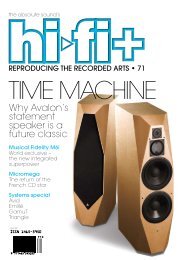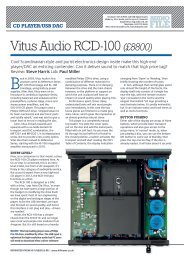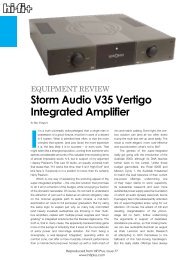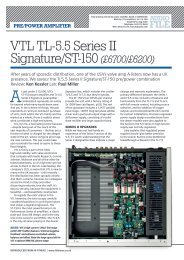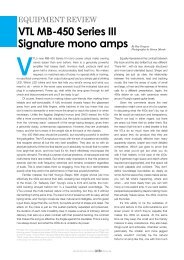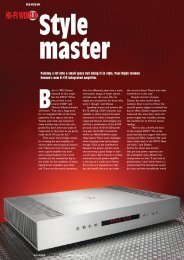TelluriumQ Iridium Amp.indd - kog audio
TelluriumQ Iridium Amp.indd - kog audio
TelluriumQ Iridium Amp.indd - kog audio
Create successful ePaper yourself
Turn your PDF publications into a flip-book with our unique Google optimized e-Paper software.
REVIEW<br />
"A" Power<br />
Tellurium Q has released a specialised Class A Single-Ended transistor power<br />
amplifier. Paul Rigby reviews their new <strong>Iridium</strong>.<br />
HI-FI WORLD<br />
REFERENCE SYSTEM<br />
Icon Audio CD-X1 CD Player<br />
Avid Acutus/SME IV/<br />
Benz Glider<br />
Icon PS3 phono amp<br />
Aesthetix Calypso Preamp<br />
Icon MB845 Monoblocks<br />
Quad ESL-57 Speakers (One<br />
Thing Modified)<br />
Tellurium Q Graphite<br />
speaker cables<br />
Tellurium Q’s Colin Wonfor<br />
doesn’t just know power<br />
supplies, he understands<br />
them. There is a difference.<br />
To illustrate, he produced<br />
power supplies for NASA’s<br />
ISS (International Space Station) to<br />
convert fuel cell voltage from 120<br />
volts DC and then 120 volts DC to<br />
28 volts DC. It was the most efficient<br />
power supply of its type in the world<br />
at that time. This is a very serious<br />
power supply designer.<br />
As such, he decided to tackle<br />
one of the toughest amplifier designs<br />
around, the Single Ended (SE) Class<br />
A. While standard push-pull Class A<br />
amps can provide very high power<br />
ratings, semiconductor SEs tend to<br />
be lower rated, around 5-10W is not<br />
unusual, requiring efficient speakers<br />
to perform properly. By their<br />
very nature SEs have no crossover<br />
distortion.<br />
But there are many hurdles to<br />
cross when designing a transistor SE,<br />
as Wonfor himself stated: “SEs are<br />
susceptible to power supply ripple,<br />
hence you have to have very large<br />
reservoir capacitors to prevent that.<br />
Otherwise, any ripple comes straight<br />
out of the speakers. The <strong>Iridium</strong> has a<br />
large capacitor, but it uses a regulated<br />
power supply so that ripple noise is<br />
even less of an issue. More than that,<br />
the regulated power supply actually<br />
tracks the amplifier, giving it what it<br />
requires at any one time, following<br />
spiky dynamics.”<br />
SEs are inefficient beasts,<br />
requiring lots of power to work<br />
correctly. In fact, the <strong>Iridium</strong> needs<br />
140W per channel just to run!<br />
But it’s this quirk that keeps the<br />
distortion low.<br />
So why don’t more designers<br />
produce transistor SEs? “All SEs have<br />
DC-offset unless they are capacitor<br />
coupled, in which case you get poor<br />
bass reproduction and control,”<br />
explained Wonfor. “Prior to the<br />
Tellurium Q design, nearly all SEs<br />
were, in fact, capacitor coupled. This<br />
power amp has a very low DC-offset<br />
and is DC coupled to the speaker,<br />
enhancing its bass control.<br />
Then you get phase angle changes<br />
at all frequencies, with muddy bass<br />
and no control. You’re relying on the<br />
impedance of the capacitor which is<br />
changing all of the time.<br />
That was the original situation.<br />
What we do is to remove that DCblocking<br />
capacitor, replacing it with a<br />
special servo system to control the<br />
DC-offset on the output. That helps<br />
solve the phase change problem too.”<br />
Inside, the <strong>Iridium</strong> power amp<br />
uses two toroidal power supplies that<br />
are mounted vertically and at ninety<br />
degrees to the circuit board so that<br />
any magnetic field produced by them<br />
does not affect the circuitry. The<br />
toroidal transformer also has twenty<br />
percent more copper than normal to<br />
reduce noise and is random wound<br />
to prevent magnetic fields squirting<br />
out of the areas with less or no<br />
wiring.<br />
There’s lots more to say about<br />
this design. It's dynamic power<br />
handling allows peaks way beyond<br />
what would be expected from a<br />
power amp of this type; low open<br />
loop gain reduces negative feedback<br />
and further helps lower phase shift<br />
and it uses two 55A MOSFETs. The<br />
company could have used a single<br />
12A MOSFET but using more and<br />
of such a high current rating allows<br />
them to be driven more effectively<br />
within their linear range which, again,<br />
gives rise to less distortion.<br />
Measuring 430x290x220mm and<br />
weighing in at a hernia straining 21kg,<br />
the <strong>Iridium</strong> power amp provides<br />
HI-FI WORLD JUNE 2012<br />
www.hi-fiworld.co.uk
REVIEW<br />
20W into 8 ohms while peaking just<br />
over 40W they claim. So what does it<br />
sound like?<br />
SOUND QUALITY<br />
First impression with the <strong>Iridium</strong><br />
power amplifier was that the<br />
distortion of the valve set-up had been<br />
removed, resulting in an extraordinary<br />
quiet base to any music pumped<br />
through the <strong>Iridium</strong>. This distortionfree<br />
sound lends itself well to detail<br />
retrieval.<br />
With distortion lowered the<br />
Sugababe’s track, ‘Stronger’, never<br />
sounded more interesting. This track<br />
is actually built upon distortion, it’s<br />
entire raison d’être is focused on<br />
compression and peak limiting and<br />
the <strong>Iridium</strong> calmed this track like no<br />
other amp I have ever heard, releasing<br />
new detail to enter from the quietude.<br />
Upper mids showed a welcome clarity<br />
while lower mids experienced an<br />
easy smoothness. The only thing that<br />
the <strong>Iridium</strong> lacked was my Icon’s air<br />
and a sense of space. The Icon added<br />
a lightness of touch that the <strong>Iridium</strong><br />
couldn’t quite approach as well as a<br />
breezy nature to the upper mids that<br />
produced an extra fragility to the<br />
treble.<br />
That said, for a solid state design,<br />
the <strong>Iridium</strong> was open, approachable<br />
and lacking in any sort of hardness<br />
or harshness, but it still had bite.<br />
That said, the <strong>Iridium</strong> is not a ‘sweet’<br />
amplifier. It can provide a mid-upper<br />
edge, one that is kept under control by<br />
the low distortion design.<br />
And the bass? It’s big, but this<br />
isn’t just heavy bass. This is bass with<br />
confident force.<br />
Moving to the HDCD version<br />
of Lou Donaldson’s ‘LD+3’ and,<br />
intriguingly, compared to my reference<br />
Icon the album sounded very smooth,<br />
if a little dry in the midrange area.<br />
Distortion was very low but this jazz<br />
piece, which relies on light, lively, airy<br />
detail had some of the life drained<br />
away. Yet, the <strong>Iridium</strong> was still very<br />
focused, precise with plenty of detail<br />
on offer.<br />
With a slight frown, I replaced<br />
that disc with Carol Kidd’s jazz-infused<br />
‘Dreamsville’ (Linn) and was somewhat<br />
bemused to be rewarded with swathes<br />
of warmth and life. The same facets<br />
that were largely absent from the<br />
Donaldson CD. What was going on?<br />
The <strong>Iridium</strong>’s pin sharp focus<br />
produced, for example, piano notes<br />
that had snooker ball roundness, with<br />
a hardness and shine, while treblebased<br />
cymbals shone with delicacy. The<br />
bass was both tight, characterful and<br />
deep with a power that provided a<br />
subtle yet significant foundation.<br />
After extended listening I realised<br />
that the <strong>Iridium</strong>’s ‘dry’ performance<br />
was nothing more than transparency,<br />
digging deep into the master to<br />
produce a revealing description. It was<br />
the Donaldson CD that was revealing<br />
its character, not the amp imposing it,<br />
in effect.<br />
Moving to vinyl and Pure<br />
Pleasure’s June Christy ‘The Cool<br />
School’, the source’s higher resolution<br />
produced a detailed,<br />
dynamic playback that<br />
was multi-dimensional in<br />
its performance, tracking<br />
the rather husky<br />
Christie vocal in all its<br />
textural magnificence,<br />
with a finely crafted, yet<br />
understated, backing.<br />
That was confirmed<br />
when playing Music On<br />
Vinyl’s ‘John Coltrane<br />
And Johnny Hartman’.<br />
Again, the Icon displayed<br />
more air and lightness<br />
of approach while the<br />
<strong>Iridium</strong>’s extra focus<br />
gave the music greater<br />
stability, planting the<br />
music firmly on stage.<br />
The Icon took a rather<br />
more flighty approach to<br />
the music which could,<br />
at times, be almost<br />
diffuse.<br />
Finally, I ran an<br />
original Throwing Muses<br />
indie rock LP, ‘House<br />
Tornado’ through the<br />
<strong>Iridium</strong> but connected<br />
one of Tellurium Q’s<br />
highly rated Black power<br />
cables (£798) to the<br />
end – recommended<br />
by the company for<br />
use with this particular<br />
power amp. The results<br />
produced an almost<br />
sublime sound, opening more doors<br />
towards blue lagoon clarity. More<br />
of the mix was available while the<br />
simple strumming of an acoustic guitar<br />
provided volumes of information<br />
compared to the restricted, one<br />
dimensional, performance of the<br />
default cable. Frankly, the Black cable<br />
gives the <strong>Iridium</strong> new bass crispness, a<br />
new tightness but also a new lightness<br />
within the upper midrange.<br />
CONCLUSION<br />
Used in conjunction with a top quality<br />
power conditioner such as Isotek’s<br />
Aquarius and/or Super Titan along<br />
with Tellurium Q’s own Black cables,<br />
you have a mighty power amplifier<br />
that possesses immense clarity and<br />
detail, strongly projected. If you want<br />
the truth from your music, then<br />
the <strong>Iridium</strong> will deliver. It is a quite<br />
remarkable piece of power amplifier<br />
technology, but then Single Ended<br />
transistor power amplifiers are rare<br />
and their sound understandably<br />
unique.<br />
(see also Noel Keywood's<br />
column on p87 for his<br />
impressions of the <strong>Iridium</strong>)<br />
There are very few single-ended (SE)<br />
transistor amplifiers around as they<br />
are difficult to design and make work<br />
properly. The <strong>Iridium</strong>’s measured<br />
performance reflects this. It produced<br />
just 18 Watts into an 8 Ohm load, but<br />
this fell to 9 Watts into a 4 Ohm load<br />
due to asymmetric output clipping,<br />
suggesting the low load, under direct<br />
couple conditions, was affecting the<br />
internal working point. This is why an<br />
output coupling capacitor is commonly<br />
used.<br />
As most loudspeakers are 4 Ohms<br />
nowadays (they nearly all use 4 Ohm<br />
bass units) that makes the <strong>Iridium</strong><br />
a 9 Watt amplifier, but this is much<br />
like valve SEs that use a single output<br />
device. Because an SE dissipates full<br />
power except when producing music<br />
the <strong>Iridium</strong> runs very hot at idle.<br />
Lack of an output capacitor brings<br />
benefits though, including a frequency<br />
response down to d.c. and lowered<br />
phase shift allowing more feedback<br />
to be applied. Output impedance of<br />
the <strong>Iridium</strong> was very low as a result,<br />
damping factor measuring an unusually<br />
high 93. This suggests very good<br />
control over bass cones and subjectively<br />
tight bass. D.C. output offset was<br />
a steady, high, but acceptable 60mV<br />
(6mV is common) on both channels, into<br />
4 and 8 Ohm loads.<br />
Distortion was low at all<br />
frequencies and outputs, our analysis<br />
showing odd order harmonics, that<br />
were produced by peak distortion<br />
MEASURED PERFORMANCE<br />
a time domain analysis showed,<br />
rather than crossover distortion. The<br />
spectrum remained fairly stable with<br />
level, a good sign, so subjectively it<br />
is unlikely the effect will be aurally<br />
obvious.<br />
The <strong>Iridium</strong> measured satisfactorily,<br />
but it must be used with sensitive<br />
loudspeakers requiring very little<br />
power; overload will be obvious, as<br />
clipping was hard.<br />
This is a very specialised amplifier<br />
with no obvious measurable benefits,<br />
but SE Class As have an ardent<br />
following based entirely upon their<br />
sound quality, which is how the <strong>Iridium</strong><br />
is best judged. NK<br />
Power<br />
18watts<br />
Frequency response 1.5Hz-60kHz<br />
Separation<br />
102dB<br />
Noise<br />
-90dB<br />
Distortion 0.03%<br />
Sensitivity<br />
1V<br />
DISTORTION<br />
HI-FI WORLD<br />
VERDICT<br />
It’s big, it’s meaty and it sounds like<br />
an ideal blend of solid state and valve<br />
technology. Buy it and then upgrade<br />
with a Black cable, toute suite.<br />
TELLURIUM Q IRIDIUM £4,800<br />
+44 (0)1458 251997<br />
www.telluriumq.com<br />
FOR<br />
- build quality<br />
- transparency<br />
- detail<br />
- clarity<br />
)<br />
AGAINST<br />
- size<br />
- weight<br />
- runs hot<br />
www.hi-fiworld.co.uk JUNE 2012 HI-FI WORLD


